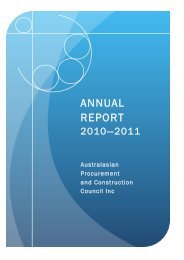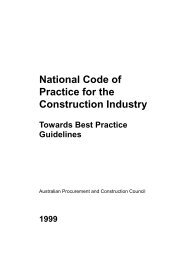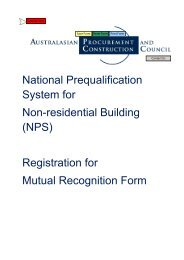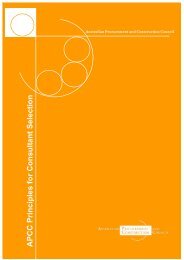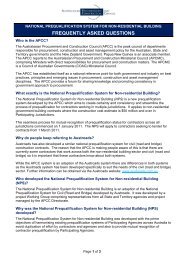Improving Security of Payment Building and Construction Industry
Improving Security of Payment Building and Construction Industry
Improving Security of Payment Building and Construction Industry
- No tags were found...
Create successful ePaper yourself
Turn your PDF publications into a flip-book with our unique Google optimized e-Paper software.
5. Pro<strong>of</strong> <strong>of</strong> <strong>Payment</strong> Page 55National Public Works Council Inc<strong>Improving</strong> <strong>Security</strong> <strong>of</strong> <strong>Payment</strong> in the <strong>Building</strong> <strong>and</strong> <strong>Construction</strong> <strong>Industry</strong>5.1 Recommendations• This Consultancy has been asked to research <strong>and</strong> advise on two approaches whichdeal with payment <strong>of</strong> amounts owing to Subcontractors. The first approach is the"Queensl<strong>and</strong> Build Approach" which has a requirement in the building contract thatthe Head Contractor must obtain from a Subcontractor a signed acknowledgment thatpayment has been received. The Head Contractor then submits a statement to thePrincipal that the Subcontractor has acknowledged payment. Further, the HeadContractor's statement will identify those Subcontractors who have not acknowledgedreceiving payment to the Principal. The Principal will then make a payment to theHead Contractor for work undertaken by the Head Contractor, together with thoseamounts paid to Subcontractors.• The second approach is the "Victorian Catholic <strong>Building</strong> Office Approach" which hasa requirement in its building contract that progress claims from the Head Contractorhave separate identifiable amounts claimed for each trade item. The total amount duefor each trade item is then paid by the Principal to the Head Contractor who must thenpay Subcontractors within six (6) days. Following pro<strong>of</strong> that Subcontractors havebeen paid, the Principal then pays the balance <strong>of</strong> the claim to the Head Contractorwithin five (5) days.• Both approaches also require a Subcontractor to acknowledge payment by the HeadContractor.• Both approaches appear to be an acceptable position in order to ensure paymentreaches the Subcontractor at the earliest opportunity. However, both approaches willnot ensure prompt payment is made to a Subcontractor where there are disputes <strong>of</strong>one nature or another, unless some mechanism is in place to settle those disputesefficiently <strong>and</strong> expeditiously.• Difficulties arise when there is pressure brought to bear by the Head Contractor upona Subcontractor such that the Head Contractor, by duress or other means, has theSubcontractor falsify acknowledgment <strong>of</strong> payment statements. Alternatively,Subcontractors may mis-use the acknowledgment <strong>of</strong> payment mechanism to pressurethe Head Contractor for payment <strong>of</strong> monies in disputes between those parties. It maybe that the Subcontractor will want to continue <strong>and</strong> extend the dispute so as topressure the Head Contractor into negotiating a better outcome for the Subcontractor.• Issues <strong>of</strong> duress, fraud, perjury, "bully boy" tactics <strong>and</strong> deceit are issues that requirebetter policing, greater penalties <strong>and</strong> a change <strong>of</strong> mind set in the <strong>Building</strong> <strong>and</strong><strong>Construction</strong> <strong>Industry</strong>. This can only be achieved through enhanced educationprograms being implemented for industry personnel. This is, by its nature, a longterm preventative position. Education cannot "stamp out" duress <strong>and</strong> fraud in theshort term.• Genuine disputes arise in the <strong>Building</strong> <strong>and</strong> <strong>Construction</strong> <strong>Industry</strong> for a whole raft <strong>of</strong>reasons, some <strong>of</strong> which include variations to the building contract, disputes as to


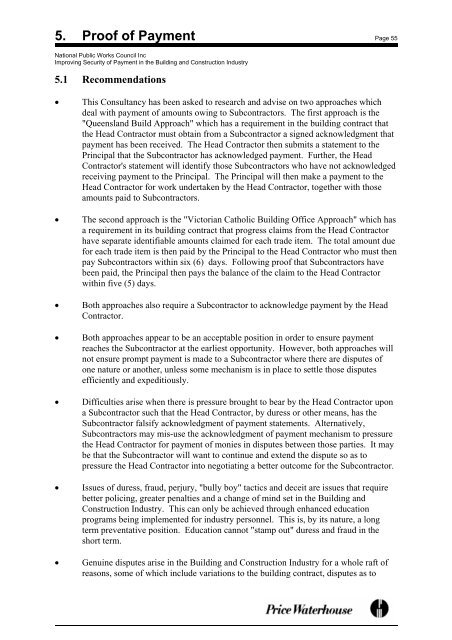

![NATIONAL COST ADJUSTMENT PROVISION EDITION 2 [NCAP2]](https://img.yumpu.com/48266135/1/184x260/national-cost-adjustment-provision-edition-2-ncap2.jpg?quality=85)



